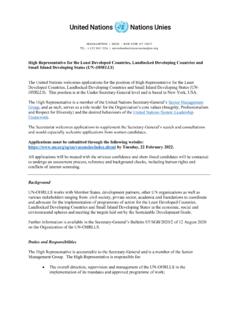Transcription of Roadmap to US$100 Billion - United Nations Framework ...
1 Roadmap to US$ 100 billion Executive Summary The Paris Agreement was a historic demonstration of all countries' collective commitment to address climate change. As part of the Paris outcome, developed countries were urged to scale-up their level of support with a concrete Roadmap to achieve the goal of mobilising US$ 100 billion per year by 2020. for climate action in developing countries. In 2016, developed countries1 worked together to develop this Roadmap , including through consultations with developing Since the commitment was made in 2010, developed countries have significantly scaled-up support to developing countries aggregate levels were estimated at US$62 Billion in 2014, up from US$52 Billion in 2013. We expect this upward trend to continue, as evidenced by the significant pledges made by many developed countries and multilateral development banks (MDBs) in 2015.
2 Providing information on future finance levels is challenging including because not all countries can provide information about future budget allocations, and because actual climate finance depends on unknowns such as recipient demand, availability of projects, and indirect economic factors. To provide analytical support for the preparation of this Roadmap , a group of developed countries asked the Organisation for Economic Co-operation and Development (OECD) to analyse the possible impact of countries' pledges on finance levels in 2020 based on what we know, or can reasonably assume, at the present time. According to analysis by the OECD (2016),3 pledges made in 2015 alone will boost public finance from an average of US$41 Billion over 2013-14 to US$67 Billion in 2020 an increase of US$26 Billion .
3 This projection is based on the significant pledges and announcements made by many developed countries and MDBs, as well as reasonable assumptions about trends of climate finance from other countries. It should be considered a conservative, indicative aggregation of public climate finance levels in 2020, rather than a firm prediction. According to the analysis, modest assumptions about increased leverage ratios would lead to projected overall finance levels in 2020 above US$ 100 billion . We are confident we will meet the US$ 100 billion goal from a variety of sources, and reaffirm our commitment to doing so through the range of actions outlined in this Roadmap . We recognise that adaptation is a priority for many developing countries. The OECD (2016) analysis indicates that the amount of public adaptation finance (bilateral and attributed multilateral) is projected to at least double in volume between 2013-14 and 2020.
4 developed countries are committed to the US$ 100 billion goal, and are confident we will meet it. This Roadmap sets out the range of actions we will take and are taking to get there, including to: - Fulfil our pledges and make further efforts to scale-up climate finance, and significantly increase finance for adaptation, in line with the priorities expressed by developing countries - Help developing countries to develop and implement ambitious mitigation contributions and adaptation plans that are essential to attract investment - Work with developing countries to address the barriers associated with access to climate finance, and to build institutional capacity and strengthen policy environments - Use public finance and policy interventions to effectively mobilise private finance, which is critical not just for the US$ 100 billion , but to achieve the Paris Agreement objectives 1 The following countries were involved in producing this Roadmap .
5 Australia, Austria, Belgium, Bulgaria, Canada, Croatia, Cyprus, Czech Republic, Denmark, European Commission, Estonia, Finland, France, Germany, Greece, Hungary, Iceland, Ireland, Italy, Japan, Latvia, Liechtenstein, Lithuania, Luxembourg, Malta, Monaco, Netherlands, New Zealand, Norway, Poland, Portugal, Romania, Slovakia, Slovenia, Spain, Sweden, Switzerland, United Kingdom, and United States. 2 The Roadmap was made publicly available in October 2016. 3 OECD (2016), Projecting climate finance to 2020, - Partner with the MDBs to deliver transformational change, and work to maximise the impact of climate funds, including the Green Climate Fund and the Global Environment Facility - Mainstream climate change into decision making, including development assistance, to align efforts to address climate change and achieve the Sustainable Development Goals - Continue to improve tracking of climate finance, to share learnings and to understand where we can collectively do better The transformation to a low greenhouse gas emission and climate resilient global economy will require efforts from all actors, beyond the scope of the US$ 100 billion goal.
6 developed countries intend to work with all countries to accelerate this transition and achieve the Paris Agreement goals. Contents: Executive Summary .. 2. 1. Context for the Roadmap .. 6. 2. Progress to date .. 6. 3. Roadmap to 2020 .. 7. Scaling-up public 9. Significantly increasing finance for adaptation .. 11. Using public finance and policy interventions to effectively mobilise private 15. Supporting enhanced access, capacity building and investment readiness .. 19. 4. Promoting transformational change to implement the Paris 22. Figures: Figure 1: Projected finance levels in 2020 .. 8. Figure 2: Estimated public finance levels in 2013, 2014, and 2020 .. 10. Figure 3: Range of projected outcomes in 2020 .. 16. 1. Context for the Roadmap In 2010, the United Nations Framework Convention on Climate Change (UNFCCC) Conference of Parties recognised that developed country Parties committed to a goal of mobilising jointly US$ 100 billion per year by 2020 from a wide variety of sources, public and private, bilateral and multilateral, including alternative sources, to address the needs of developing countries, in the context of meaningful mitigation actions and transparency on implementation.
7 2015 was a historic year, in which all countries agreed to ambitious goals to strengthen the global response to climate change through the Paris Agreement they adopted at the UNFCCC Conference of Parties (COP21). Achieving these goals will require a comprehensive shift in finance flows and investment patterns, in line with the aim in Article (c) to make finance flows consistent with low emissions and climate resilient development pathways. The US$ 100 billion goal can play a catalytic role in this wider finance landscape, and is an important measure of developed countries' efforts to assist developing countries to enhance their climate action. In Paris, the UNFCCC Conference of Parties (COP21) adopted a decision strongly urging developed country Parties to scale-up their level of financial support, with a concrete Roadmap to achieve the US$ 100 billion goal, while significantly increasing finance for adaptation and to further provide appropriate technology and capacity building In keeping with the spirit of Paris, developed countries are pleased to respond to this call with the following Roadmap '.
8 The Roadmap aims to build confidence and provide increased predictability and transparency about the actions developed countries are and will be taking to achieve the US$ 100 billion goal. The Roadmap outlines the key factors and pathways to reach the goal, and what actions will influence progress over the remainder of this decade. It also reflects on action developed countries are taking, together with our partners, to transform broader finance flows and investment patterns, consistent with the goals set out in the Paris Agreement and the Sustainable Development Agenda. In preparing the Roadmap , we have consulted with developing country Parties and groups, multilateral development banks (MDBs), the Green Climate Fund (GCF) and Climate Investment Funds (CIFs), as well as non-government organisations and experts.
9 We have also sought expert analytical support from the Organisation for Economic Co-operation and Development (OECD). The OECD's analytical note is available 2. Progress to date Since 2010, developed countries have significantly scaled-up the level of financial support provided and mobilised to developing countries. We have also made concerted efforts to improve the transparency of climate finance so we can better understand what finance is being mobilised, where there are positive precedents to build on, and where we can do better. In 2015, the OECD, in collaboration with the Climate Policy Initiative (CPI), prepared a report on climate finance mobilised towards the US$ 100 billion The report was prepared at the request of the Peruvian and French governments as the outgoing and incoming presidencies of the UNFCCC Conference of It estimated that the aggregate volume of public and private climate finance mobilised by developed countries for developing countries reached US$62 Billion in 2014, up from US$52 Billion in The 4 Paragraph 114 of decision 5 OECD (2016), Projecting climate finance to 2020, 6 The OECD (2015) report covers the period 2013-14.
10 It found that average finance over this period was $57 Billion . As 2015 data on finance flows are not yet available for most countries, this is the most up to date assessment as of the date of release of this Roadmap . 7 OECD (2015), Climate finance in 2013-14 and the USD 100 billion goal , a report by the Organisation for Economic Co-operation and Development (OECD) in collaboration with Climate Policy Initiative (CPI), 8 These aggregate estimates of climate finance, as well as those projected volumes in 2020 referred to in this Roadmap , do not include finance related to coal projects. However, Japan and Australia consider that financing for high efficiency coal plants should also be considered as a form of climate finance. In addition to the figures in the OECD (2015) report, Japan provided US$ Billion for such 6.
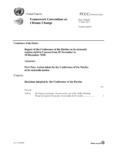
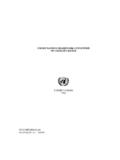

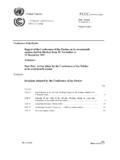

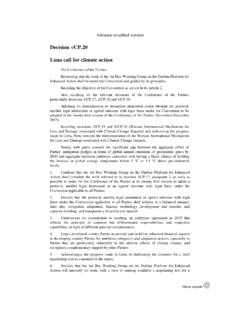
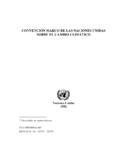
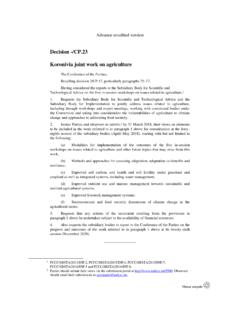
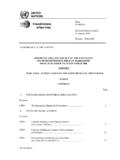
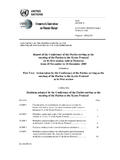


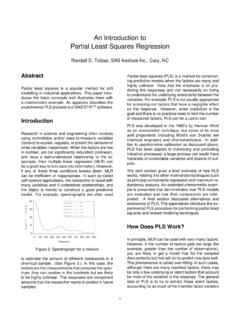


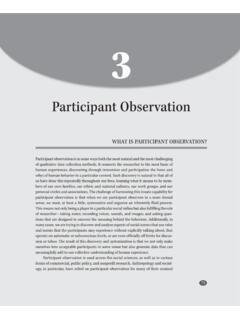
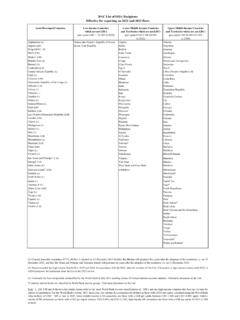
![À o } } µ v ] ~ } ( í í & µ Ç î ì ... - United Nations](/cache/preview/6/8/a/d/6/2/7/a/thumb-68ad627a8e8bb0028fb1d792ee150919.jpg)
